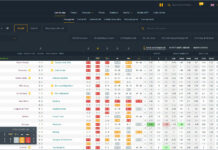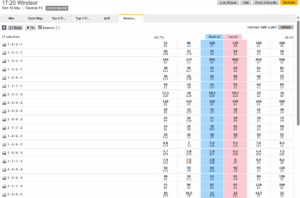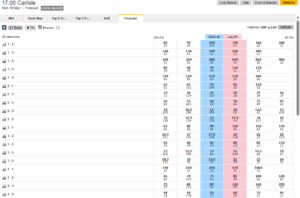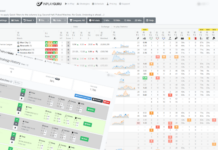Horse racing betting has evolved dramatically over the years, with two distinct options emerging to suit every type of punter:
- Traditional bookmakers
- Betting exchanges
In this article, we’ll explore the various different horse racing bet types offered by the aforementioned market makers, and how each of these can influence your bets and strategy.
Traditional bookmakers offer fixed odds set by the house. This means that when you place a bet, you’re accepting the odds determined by the bookmaker alone, giving you a straightforward transaction where the potential return and risk are clearly defined.
However, sports betting exchanges operate like an open marketplace, putting you in direct competition with other punters. With betting exchanges, you can both back a horse to win and lay a bet against it to lose, essentially acting as your own bookmaker. We’ll explain how to bet on horse racing exchanges.
Due to the nature of the open market offered on betting exchanges, the odds available to punters are much higher than those offered by bookmakers, while also offering bettors the ability to bet against a horse winning.
To cut a long story short. Unless you’re betting on multiples, where a bet is spread across the outcome of multiple races, the only place you should be making any horse racing bets is with sports betting exchanges.
For the purpose of the remainder of this article, we’ll look at the various horse racing bet types offered by the popular sport betting exchange, the Betfair Exchange.
Table of Contents
Win Bets (Back Bets)
A win bet is the most straightforward type of bet in horse racing. You’re betting on a single horse to come in first place. If your chosen horse wins the race, you receive your payout based on the odds taken. If it doesn’t finish first, you lose your stake.
To complicate things a little, win bets can be placed in two formats. Either with the available odds at the time of placing the bet, or punters can opt to place a start price bet. With start price bets, the odds are only calculated at the time the race turns inplay (starts), and are roughly in line with the current price at this time.

In the above image the horse racing bet types on the win market and back bets (in blue) and lay bets (in pink). We’ll go into more detail on lay betting in the next section of this article.
We’ll provide this first example of a win bet with both fractional and decimal odds, but after this point all odds references will be made in the decimal format, as these are preferred by most good punters.
Race selection: We place a win bet on the horse ‘I Am Maximus’, at 5/1 fractional or 6.0 decimal odds.
Odds types explanation:
- Fractional Odds: If offered at 5/1, it means for every £1 staked, you win £5 in profit (plus your original stake back).
- Decimal Odds: The fractional odds of 5/1 correspond to 6.0 in decimal, where every £1 staked returns £6 in total (the profit, plus the stake).
Possible outcomes:
If I Am Maximus wins:
- Fractional Calculation: For every £1 staked at 5/1, you win £5. So, with a £10 bet, your winnings are 5 × £10 = £50. Then add your original stake back, giving a total return of £60. Minus the £10 stake this = £50 profit.
- Decimal Calculation: Multiply your stake by the decimal odds: £10 × 6.0 = £60 total return. Your profit here is the return minus your stake, which is £60 – £10 = £50.
If I Am Maximus does not win:
- You lose your £10 stake.
As you can see in the example above, the payout is exactly the same whether using fractional or decimal odds. The difference being decimal odds are much easier to read, for example:
- Fractional Odds: 13/8
- Decimal Odds: 2.63
With a glance, it’s possible to see that with a £10 bet the payout would be £26.30 and a profit of £16.30, when using decimal odds. With or without a Phd in Maths, the fractional equivalent would take some time to calculate your winnings, or potential winnings prior to placing any bets.
Lay Bets (Lose Bet)
Lay bets are a key feature of sports betting exchanges, allowing the punter to step into the role of the bookmaker. Rather than betting on an outcome to occur (a ‘back bet’), you wager that a specific event will not happen (a ‘Lay bet’).
For example, rather than backing a horse to win, you might lay that horse and in effect place a bet that they will not win. This means that if the horse loses, you win your bet, but if it wins, you’re liable to pay out to the backer, who placed a back bet at your offered odds.
A key aspect of lay betting is that you don’t risk only your stake, you risk a calculated liability from the odds which the lay was placed at, which is the amount you must pay if the selection wins. Liability is calculated using the decimal odds of the lay bet. The formula is:
Liability = (Decimal Odds – 1) × Lay Stake
Here’s an example below:
Example: A lay bet is placed on a I Am Maximus (not to win) at decimal odds of 6.00, with a lay stake of £10.
-
- Calculation:
- Liability = (6.00 – 1) × £10
- Liability = 5.00 × £10
- Calculation:
- Liability = £50
- Outcome:
- If I Am Maximus wins, you must pay out £50 to the backer who placed the corresponding back bet which was matched to your lay bet.
- If the horse does not win, you keep the backer’s stake (£10) as your profit.
As many horses’ decimal odds are in double or triple figures, it’s essential to understand the risks & liability calculation before placing any lay bets. Refer to the image below of a Betfair Exchange horse racing market. To place a traditional back bet, use the blue buttons on the left. If you’re planning on placing a lay bet, use the pink buttons on the right.
[IMAGE – BETFAIR HORSE RACE WIN MARKET SCREENSHOT, WITH LAY BET SET UP]
Potential profit and liability will always be displayed on page as you adjust your stake or the odds prior to confirming the bet, be that a back or lay.
As betting exchanges do not operate like bookmakers and offer this peer-to-peer exchange betting, the odds on offer are almost always much higher than those available with bookmakers.
Each Way Bets, E/W Bets
Each-way betting or E/W bets in horse racing are two separate bets placed as a single E/W bet. They consist of a bet on the horse to win and another on the horse to “place” (finish within a pre-specified range of top places). When you place an each-way bet, you wager two equal stakes.
If your horse wins, both elements payout. If the horse just places, you only receive the payout on the place portion at a fraction of the win odds. This fraction is usually either 1/5 or 1/4, depending on the race conditions and the betting exchange or bookmaker’s rules.

The number of places paid out for the place element of an each way bet are calculated as follows:
2–4 Runners: Each-way betting isn’t available because the field is too small. In these cases, you’re generally limited to win-only bets. There may however be a separate market to bet on for a 2nd place finish, if there are 3+ runners.
5–7 Runners: Betting exchanges & bookmakers generally payout on the first two places, 1st & 2nd, with the place half of the bet calculated at 1/4 of the winning odds.
8–15 Runners: The standard each-way terms generally pay out on the first three places (first, second, and third) at 1/5 odds.
Handicap Races and Larger Fields: Some races, especially handicaps with 12–15 runners, might offer enhanced terms (e.g. three places at 1/4 odds). For races with 16 or more runners which are usually handicap races, you should see four places paid.
Additionally, in big events like the Grand National sometimes even more attractive each-way terms are offered (sometimes covering up to five or six places), as a way to offset the challenge of picking a winner in a very large field.
Place Bets & Extra Places Bets
A place bet on a sports betting exchange is a wager that wins if your chosen selection finishes within a fixed group of top positions rather than winning outright. Unlike a win bet which only pays if your selection comes first, a place bet wins as long as your chosen runner finishes within the specified positions (most commonly, the top three finishers). Place bets are essentially the second part of an each way bet, that we outlined earlier in this article.

The key difference with place bets on sports betting exchanges is that they are paid out at the odds taken on the specific place market you choose, be that 2 places, 3 places, 4 places, etc. Each market has it’s own odds, which is what bets are settled at regardless of the actual place the horse finishes in.
Also on offer at betting exchanges are extra places. In a 10 runner race you will get paid if your horse finishes in the top three, but with extra places, betting exchanges extend this to an additional position, and also a finishing position less.

e.g If the standard place payout for a particular race applies to the top three places, extra places markets would include a four places market and also a two places market. As such either reducing risk or potentially increasing your return if you opt for the two places variation, with the odds on offer obviously being much higher in the later, as the chance of finishing in the top two places is much lower than the top 3 places.
Forecast Bets & Reverse Forecast Bets
With a forecast bet, the punter picks the first and second finishers in the precise order they believe they will finish. For example, let’s say we’re looking at a horse race and decide to place a forecast bet backing Horse A to win and Horse B to finish second. If the race result is exactly ‘Horse A 1st & Horse B 2nd’ then the bet is a winner, and the payout received will be as per the market odds taken. If we stake £10 and the odds taken were 11.50, we would receive a £115.00 return (which includes the original stake).
We also have the option of a reverse forecast bet, where both finishing orderings are covered for the two selected horses. This is essentially placing two separate straight forecast bets, although your stake is not doubled as it is with each way bets:
- One bet on “A-B”
- And another on “B-A”
In this scenario, if either forecast is correct you win the bet.
AvB Bets
AvB bets on betting exchanges are head-to-head wagers where two specified competitors are pitted directly against each other.
The attraction of AvB betting is that the punter can effectively bet on a race within a race between two horses, which are not necessarily the favourites.

As with all the bet types we’ve mentioned in this article these bets work just like other exchange bets, letting you either back your chosen competitor to win or lay them (betting that they won’t finish in front).
Horse racing bet types – Conclusion
Betting exchanges have transformed the horse racing betting experience by offering a dynamic, peer-to-peer marketplace that rewards savvy bettors with higher odds and thus better returns.
By letting you set your own prices, and even step into the role of the bookmaker through the use of lay bets, sports betting exchanges empower the punter to capitalize on market inefficiencies that fixed odds simply can’t match. This all leads to significantly higher payouts when compared to traditional methods.
If any further proof is required, check out the image below which is a screenshot from Timeform.com displaying the Cheltenham Gold Cup result from 2025, including the betting exchanges start prices and industry (bookmakers) start prices.
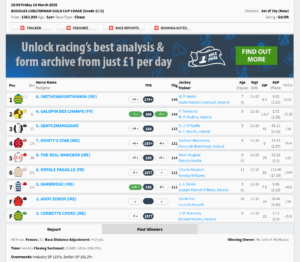
That said, bookmakers still hold an important place in the betting ecosystem. They offer simplicity and clarity, making for straightforward transactions that are especially appealing to those who prefer a more leisurely betting approach.
Additionally, bookmakers offer certain exotic bet types, such as trifecta, multiple accumulator markets and many more exotic bet types, which aren’t available on betting exchanges, apart from where we have detailed earlier in this article. These bet types provide additional opportunities, particularly for bettors who value the variety of wagering options, and enjoy the traditional feel of the betting establishment.
If you thrive on flexibility, dynamic pricing, and the challenge of leveraging your market insight, a betting exchange is likely the superior choice for horse racing. However, if you value simplicity, and exclusive bet types, then staying with a bookmaker might be a better fit for your needs.
IMPORTANT NOTE: Don’t forget to LIKE and FOLLOW us on the various social media channels we post updates on, also on our homepage we have a Newsletter Subscription form. Like, Follow us & join the Newsletter to be sure you don’t miss a thing!
Feel free to use the social sharing buttons included on this page, they’re there for your use.
Thanks for visiting TheBetMatrix.Win – We’ve plenty more sports betting content, available at your convenience.
Frequently Asked Questions (FAQ):
What is the difference between a back bet and a lay bet in horse racing?
A back bet is betting on a horse to win; a lay bet is betting against it.
Can you place each-way bets on betting exchanges?
Yes, many betting exchanges including the Betfair Exchange support each-way betting, typically by placing two separate bets.
Is in-running (inplay) betting available on all horse races?
Almost, you’ll be hard pressed to find a betting exchange that don’t offer in-running markets, where bets can be placed after the race begins.

